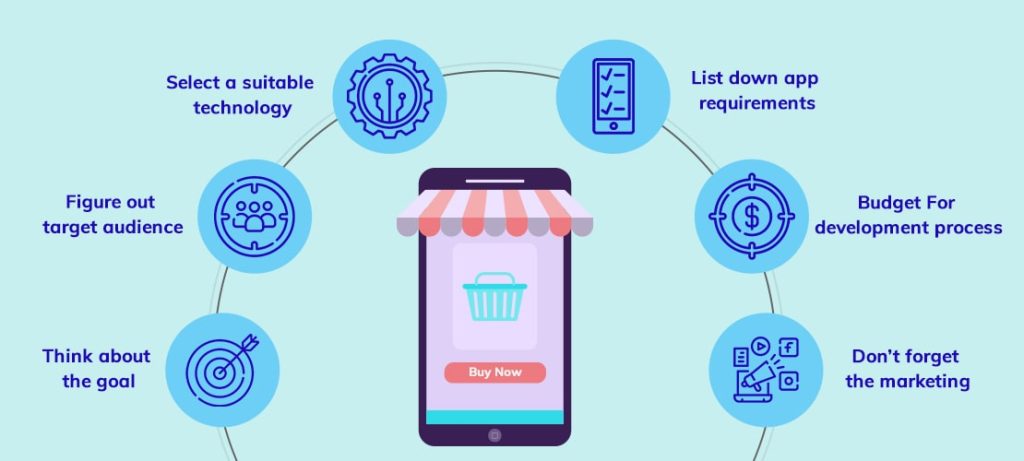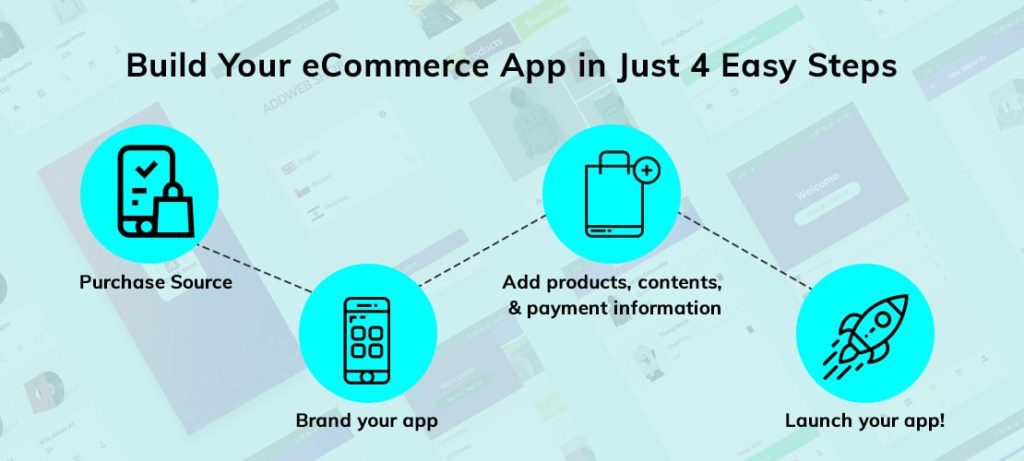Launching an eCommerce app isn’t a question of how and why anymore; instead, it is more about doing it correctly. Today, the app stores are flooded with a wide range of mobile apps for eCommerce business. And such a vast volume leads to immense competition, which makes it a daunting task for businesses to get the maximum benefit from their eCommerce app & website development.
However, as a surprising fact, approximately 80% to 90% of the eCommerce apps launched in the app store were abandoned just after being used once. And there are a few reasons behind it, such as a weak product list, incorrect launch time, lack of marketing strategy, etc.
So, what does it take to develop an eCommerce mobile app that will work for you? What does it take to build a React Native eCommerce mobile App that brings more visitors, sales, and frequent purchases? Let’s try to understand several critical aspects of building a mobile app for the eCommerce business.

Think about the goal to develop an eCommerce mobile app
eCommerce app & website development. It is crucial to know what you want and how you will measure the success of your mobile app for the eCommerce business. You can think of the following essential things to determine goal eCommerce development:
- Where do you stand in the market?
- How much traffic does your store generate at present?
- How many visitors do you get from mobile devices?
- What is the conversion rate from mobile devices?
If you can figure out the answers to all these questions, you can quickly determine your mobile app’s goal. Based on your business, you may wish to optimize your checkout process and improve the mobile app’s conversion rate for the eCommerce business. If you are running a B2B eCommerce store, your goal could be the customers’ loyalty. In any of these goals, you can get help from an eCommerce development company to develop an eCommerce mobile app.
Also Read: Challenges of eCommerce That Every Online Retailer Will Face
The next step is to figure out your target audience
Once you are aware of what you want to achieve from the mobile app, the next thing you have to do is to identify your target audience. It will help you streamline your app development process and will be assisting in improving your marketing efforts. You can think about the following things:
- Age group
- Consumer interest
- Type of products
How they find you Finding answers to these simple things would help you conclude your target audience and will be the base for developing a mobile app for the eCommerce business.
Select a suitable technology for your eCommerce app
Now that you have a clear idea about what you want and for whom, it is time to think about what type of app you want. There are two options for the eCommerce retailers: either they can opt for progressive web apps or react native eCommerce apps. If you want a generic app that works on all platforms, then progressive web apps are the right choice. But if you want a platform-specific app, then go for native apps.
List down all your app requirements.
Now you are done with the prerequisites of eCommerce app development; you have to start working on the requirements aspect. Discuss with your team about the features and functionalities you wish to have in the mobile app. Starting from the product listing page, checkout process, and payment options to the notifications, there are a bunch of things you have to work upon. Once you have made the list of features, move on to the next step of budgeting and development.
Also Read: Key Factors That Can Affect Cost of Your eCommerce Mobile App
Decide on the budget and development process.
You have all the ingredients on the table with you that can help you imagine your dream eCommerce app. But to make it successful, you have to think about two crucial aspects: Budget and Development. Do you know how much time, money, and resources required to build your eCommerce app? The answer would be a big no. You can get in touch with a professional eCommerce development company or hire a dedicated developer considering your budget and timeline. So, start your hunt to find the right talent that can help you develop your eCommerce app within your budget and timeline.
Don’t forget the marketing!
The last but not the least thing you should think about is marketing your eCommerce app. You might have the world’s best eCommerce app, but what if it doesn’t get any downloads at all? That’s where the marketing would come into the picture. Spare enough time to plan the marketing strategy and start working on it even before you think of launching your eCommerce app.
Looking for a more efficient way other than discussed above?

Well, try to find ready-made eCommerce app building solutions available in the market. Such ready-to-use solutions won’t just help you simplify the overall eCommerce app development process but also reduce the overall eCommerce app development cost. Now that you know vital ingredients that can help you build a successful eCommerce app.
Frequently Asked Questions
Explore crucial factors such as target audience, market research, and competition analysis to understand your business niche and plan accordingly for your app.
A mobile-first approach is essential as a significant portion of users shops via mobile devices. Prioritizing mobile responsiveness and optimizing the user experience for smaller screens can significantly impact the app’s success.
Basic features like user registration, product listings, a secure payment gateway, and a smooth checkout process are fundamental. Advanced features such as personalized recommendations and social sharing can enhance user engagement.
A seamless and intuitive UX is crucial for user satisfaction. Elements like easy navigation, fast load times, and clear product information contribute to a positive user experience, encouraging users to explore and make purchases.
Personalization, including tailored recommendations, user preferences, and personalized marketing messages, can significantly enhance the user experience and increase customer engagement and loyalty.
Mobile responsiveness ensures that the app works seamlessly across various devices and screen sizes. Cross-platform compatibility is achieved through native development or cross-platform frameworks, catering to a broader audience
Effective marketing involves a combination of strategies, including app store optimization (ASO), social media marketing, influencer collaborations, and email marketing. Creating a pre-launch buzz and ongoing promotional efforts are crucial for success.
Continuous improvement based on user feedback, timely bug fixes, and regular updates with new features contribute to the app’s success. Maintaining a positive relationship with users through customer support is also vital for long-term success.
